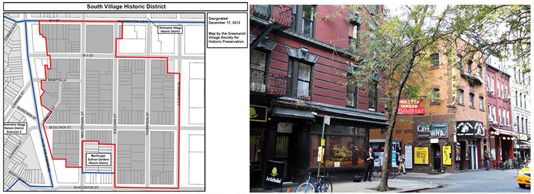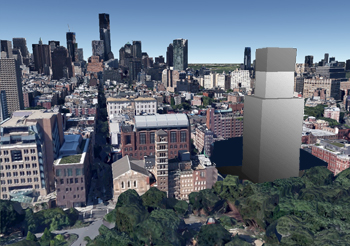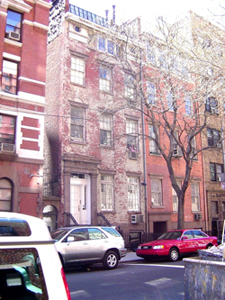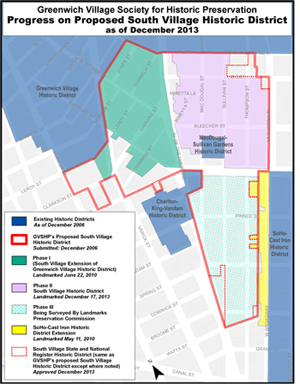
|
Map of the newly-landmarked South Village Historic District (l); MacDougal Street and Minetta Lane in the newly designated district, with Minetta Tavern and Café Wha? |
Manhattan — The NYC Landmarks Preservation Commission (LPC) voted today to landmark the South Village Historic District (map), a two hundred forty-building, thirteen-block section of Greenwich Village south of Washington Square Park, and the second phase of the Greenwich Village Society for Historic Preservation’s (GVSHP) proposed South Village Historic District (the first phase of which was landmarked in June of 2010). GVSHP first proposed landmark designation of the South Village ten years ago, and submitted a formal landmarking proposal with boundaries to the City in 2006.
GVSHP will hold a celebration and look at “next steps” for preserving the South Village tonight from 6 to 7 pm at Le Poisson Rouge, 158 Bleecker Street in the newly-landmarked South Village Historic District (and the space previously occupied by the historic Village Gate Theater). The celebration is open to the public and all are welcome!

Today’s landmark designation of the South Village brings to over 1,100 the number of buildings in the Village, East Village, and NoHo which the Greenwich Village Society for Historic Preservation has helped secure landmark designation of over the last ten years.
The historic district landmarked today includes a rich array of 19th and early 20th century sites connected to the development of this neighborhood as a mecca for immigrants — largely Italian-American — and for artists, writers, and musicians in the 20th century, especially those connected to the Beat Movement and the Folk Revival in the 1950s and 60s. With landmark designation of this district, which takes immediate effect, this is the largest expansion of landmark protections in the South Village since 1969, when the Greenwich Village Historic District was designated.

|
Image of structure which could be built on NYU Vanderbilt Hall site without landmarking (click to view more). |
Landmark designation prohibits demolitions and alterations of existing buildings without the permission of the Landmarks Preservation Commission, and tightly controls new development to ensure it is in character with the neighborhood. In recent years, NYU and private developers have made several large incursions into the neighborhood, including a series of oversized, out-of-character buildings on Washington Square South. However, GVSHP successfully fought to have two potential NYU development sites included in the landmark district which the LPC initially excluded — NYU’s Vanderbilt Hall and Kevorkian Center, both on Washington Square South. Without landmark protections, the low-rise brick NYU Vanderbilt Hall could be replaced with a 300 ft. tall dormitory (see images); today’s vote prevents any demolition or new construction on that site without landmarks approval.
“This is a long-overdue victory for this neighborhood and for anyone who loves New York’s rich immigrant history and long tradition of cultural innovation. The South Village was the birthplace of modern American Theater, the place where cappuccino was first introduced to America, the site of Dylan’s earliest performances and where he wrote Blowin’ In the Wind, where Lenny Bruce was arrested for obscenity, and the home of America’s first non-profit theater and the city’s first progressive school.  Few places embody as much history as the South Village, and few places were in as great of danger of losing that history — in this case to NYU and by other inappropriate development. This landmark designation so many of us fought for years to achieve will help ensure this great history is now preserved,” said Andrew Berman, Executive Director of the Greenwich Village Society for Historic Preservation. Few places embody as much history as the South Village, and few places were in as great of danger of losing that history — in this case to NYU and by other inappropriate development. This landmark designation so many of us fought for years to achieve will help ensure this great history is now preserved,” said Andrew Berman, Executive Director of the Greenwich Village Society for Historic Preservation.
The South Village has faced increasing danger in recent years. In 2012, the Preservation League of NY State joined with GVSHP to name the South Village one of New York State’s “Seven to Save,” one of the seven most endangered historically significant sites in the State. Earlier this month, New York State approved GVSHP’s nomination of the entire South Village for listing on the State and National Register (SNR) of Historic Places, which will offer tax breaks and other financial incentives for preservation of historic properties, and make sure the area is protected from State or Federal actions or projects or use of State or Federal funds that would harm its historic character (SNR district map and photos here, nomination here).

|
Click to enlarge. |
At today’s vote, however, the LPC did remove ten houses at 130-148 Houston Street from the South Village Historic District before they designated it. The LPC has also not yet made a commitment to move ahead on landmark designation of the highly endangered third phase of GVSHP’s proposed South Village Historic District, the area south of Houston Street, which has been subject to especially great development pressure since the approval in early 2013 of the Hudson Square Rezoning, which is directly adjacent to that part of the South Village.
“Today’s vote was a great victory for everyone who fought so hard to make it happen, but we still have a lot of work to do. Phase III of our proposed landmark district south of Houston Street still desperately needs protections. In the new year with the new administration, we will be pushing hard to landmark the remaining unprotected areas of the South Village, and proposing new zoning protections for the neighborhood to prevent out-of-scale development” added Berman.
Following today’s vote by the Landmarks Preservation Commission, GVSHP sent a letter requesting Community Board #2 hold a hearing and pass a resolution urging the Landmarks Preservation Commission to move ahead with “Phase III” of GVSHP’s proposed South Village Historic District. Councilmember-elect Corey Johnson also wrote to the LPC Chair urging him to move ahead with “Phase III.”
Additional images of buildings within the South Village Historic District landmarked today can be found here.
Some important sites included within the new South Village Historic District include:
-
Café Reggio, 119 MacDougal Street — coffeehouse noted for attracting artists and musicians beginning in 1927, including Bob Dylan; where cappuccino was introduced in America (image)
-
130-132 MacDougal Street houses — owned by Bronson Alcott, his daughter Louisa May Alcott lived there for a time and is believed to have written parts of Little Women there (image)
-
Little Red Schoolhouse, 200-202 Bleecker Street - founded in 1921, this was the first “progressive” school in New York. The red houses from which the school gets its name date from 1826 (image)
-
Former Mills House No. 1, 160 Bleecker Street - an early and influential experiment in reform housing built in 1896 to the designs of renowned architect Ernest Flagg, this building originally provided lodging for 1,500 single men along with communal space and social services in what were considered generous and humane conditions for the time (images here and here)
-
Former Village Gate theater, 158 Bleecker Street — Located in the first floor and basement of Mills House No. 1, the Village Gate was one of the premier jazz, rock, and folk music venues of the mid-20th century. Bob Dylan wrote “A Hard Rain’s A Gonna Fall” here (image)
-
Former Fire Patrol No. 2, 84 West 3rd Street — Built in 1906, the Fire Patrol was a private fire insurance service which pre-dated the New York City Fire Department, with roots connected to Benjamin Franklin. The house has been renovated and converted to a private residence by Anderson Cooper (image)
-
Minetta Tavern and Café Wha?, MacDougal Street and Minetta Lane — two of the storied gathering spaces in the neighborhood from its bohemian heyday. Bob Dylan’s first performance after arriving in New York was at Cafe Wha? Peter, Paul, and Mary also performed there and Jimi Hendrix was “discovered” there in 1966. Minetta Tavern was a popular literary haunt in the 1920s, attracting the likes of E. E. Cummings, Joe Gould, Ernest Hemingway, Eugene O’Neill, and Ezra Pound (image)
For more information about the South Village and its history, see:
|